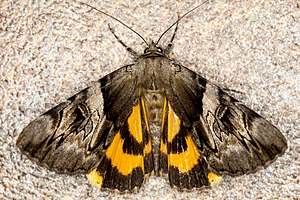Yellow ribbon
| Yellow ribbon | ||||||||||||
|---|---|---|---|---|---|---|---|---|---|---|---|---|

Yellow ribbon ( Catocala fulminea ) |
||||||||||||
| Systematics | ||||||||||||
|
||||||||||||
| Scientific name | ||||||||||||
| Catocala fulminea | ||||||||||||
| ( Scopoli , 1763) |
The yellow ribbon ( Catocala fulminea ) is a butterfly ( moth ) from the owl butterfly family (Noctuidae).
features
The moths reach a wingspan of 44 to 52 millimeters. These are usually brown, but sometimes also yellow or gray-brown in color. The pattern of the forewings is very pronounced. The hind wings are reddish yellow with two black bands. The caterpillar has a particularly long spine on the eighth segment. The "fringes" on both sides use the bark-like coloration for better camouflage and, in the wind, also for better adhesion.
Geographical distribution and habitat
The yellow ribbon is widespread from northern Spain and central France to the Baltic Sea. The species is absent or rare in the south of the Alps, Albania , Montenegro and Greece . In contrast, it is more widespread in the east. The further distribution area extends to the Black Sea , the Caucasus , to southern Siberia and the Pacific Ocean .
In Austria the species has been found in all federal states, but it is very rare. In Germany there are stable populations in the Upper Rhine Graben and the Swabian Alb, among others.
You can find this species in warm, dry and sunny places such as slopes, clearings, forest edges, in valleys with many hedges, on country roads lined with trees and in organically managed orchards. Due to the very special biotope requirements , this species is becoming increasingly rare. However, some populations can still be found in the south-east of the temperate zones of Europe .
Way of life
The moths can be found, depending on the weather, from early June to early August and the caterpillars from late March to early June. They belong to the earliest Catocala species occurring in the year. The caterpillars hatch from the overwintering eggs when the first sloes start to bloom. They feed on the flowers until the leaves sprout. The caterpillar season begins earlier or later, depending on the area, and ends earlier or later.
The caterpillars feed mainly on sloe , and hawthorn ( Crataegus ), pear ( Pyrus ) and oak ( Quercus ) are also mentioned to a lesser extent . The slender caterpillars imitate small branches. They stay at the lower part of the tree and, like all ribbon caterpillars, are nocturnal. They begin to eat around midnight. Stick shoots and bush-shaped trees are preferred. The moths drink using their proboscis sometimes tree sap and can - like all ribbon types - easily with a bait are attracted.
swell
Individual evidence
- ^ Austria Lexicon: Ribbons
- ↑ a b c d e f Günter Ebert (Ed.): The Butterflies of Baden-Württemberg Volume 5, Moths III (Sesiidae, Arctiidae, Noctuidae). Ulmer Verlag Stuttgart 1997. ISBN 3-800-13481-0
- ^ Moths and Butterflies of Europe and North Africa: Catocala fulminea. Paolo Mazzei, Diego Reggianti, Ilaria Pimpinelli, accessed December 19, 2007 .
literature
- Manfred Koch : We determine butterflies. Volume 3: Owls. 2nd, expanded edition. Neumann, Leipzig / Radebeul 1972, DNB 760072930 .
Web links
- www.lepiforum.de
- www.schmetterling-raupe.de
- Moths and Butterflies of Europe and North Africa (English)
- Markku Savela: Lepidoptera and some other life forms (English)
- Catocala fulminea at Fauna Europaea